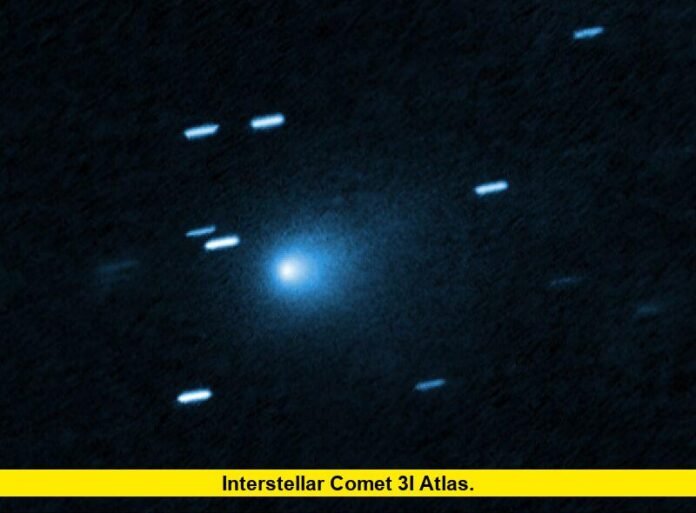The interstellar comet 3I/ATLAS has become one of 2025’s most exciting astronomical discoveries. Identified in early July 2025, this cosmic traveler from beyond our solar system has fascinated scientists and sky-watchers alike. Interstellar comet 3I/ATLAS represents only the third confirmed interstellar object ever observed—following ‘Oumuamua (1I/2017 U1) and Borisov (2I/2019 Q4)—making it a truly rare event in modern astronomy.
A Discovery Beyond Expectations
The discovery of 3I/ATLAS was made by the Asteroid Terrestrial-impact Last Alert System (ATLAS) in July 2025. Astronomers quickly realized that this object was traveling too fast to be bound by the Sun’s gravity—meaning it originated from outside our solar system. Its incoming velocity of around 130,000 miles per hour (about 209,000 km/h) confirmed its interstellar nature.
The comet’s highly hyperbolic trajectory—unlike the elliptical orbits of typical solar-system comets—shows that it is simply passing through before returning to the depths of interstellar space.
Key Facts About 3I/ATLAS
| Feature | Details |
|---|---|
| Official Name | Interstellar Comet 3I/ATLAS (C/2025 N1) |
| Discovery Date | July 1, 2025 |
| Discovery Site | ATLAS Survey Telescope, Chile |
| Speed | ~130,000 mph (209,000 km/h) |
| Closest Approach to Sun (Perihelion) | October 29–30, 2025 (≈ 1.4 AU from the Sun) |
| Closest Approach to Earth | ≈ 1.8 AU (~167 million miles) |
| Estimated Nucleus Size | Between 320 meters and 5.6 kilometers across |
| Tail Formation | Active, with dust and gas emissions forming a visible coma |
A Rare Visitor From Another Star System
Every interstellar object provides a unique scientific opportunity. While ‘Oumuamua was an enigmatic, elongated rock with no visible tail, and Borisov resembled a typical comet, 3I/ATLAS combines qualities of both. It shows clear outgassing activity (a visible tail) but also possesses an unusual composition, possibly indicating a more complex history.
Spectral observations revealed that 3I/ATLAS has a carbon dioxide-rich coma, along with traces of water ice and organic compounds. This suggests that it may have formed in a cold, outer region of another planetary system before being ejected into interstellar space—likely due to gravitational interactions with larger planets.
The Science Behind the Observation
Telescopes across the world, including ground-based observatories and orbital instruments like the Hubble Space Telescope and James Webb Space Telescope, have turned their focus toward 3I/ATLAS.
Their goals include:
- Determining the comet’s composition: By studying the emitted gases and dust, scientists hope to learn how similar or different 3I/ATLAS is from comets born in our solar system.
- Estimating its origin: Subtle differences in isotopic ratios may reveal the type of star system it came from—possibly one with chemical properties unlike the Sun’s.
- Monitoring activity: As the comet approaches perihelion, the increase in solar radiation could cause significant brightening, offering clues about how its ices react to heat after millions of years in deep space.
Why 3I/ATLAS Matters for Science
Each interstellar visitor is a snapshot of another star system’s building blocks. Because 3I/ATLAS formed far from our Sun, its materials remain mostly unaltered since the birth of its parent system. By analyzing its dust and gas, scientists can study chemistry that predates our solar system itself.
This discovery also pushes the boundaries of space mission planning. NASA and other agencies are exploring how future spacecraft could intercept or observe such high-speed visitors. Even though 3I/ATLAS is already too fast for current missions to chase, the data from this encounter will guide strategies for intercepting future interstellar comets.
A Safe but Distant Encounter
Despite its attention-grabbing speed and interstellar origin, 3I/ATLAS poses no threat to Earth. Its closest approach—about 1.8 astronomical units away—places it well beyond Mars’ orbit.
From the United States, amateur astronomers with large telescopes might catch faint glimpses of its tail in the coming months, particularly in dark-sky regions of the Southwest. Its brightness is expected to peak around late October 2025 before fading again as it travels back toward interstellar space.
How It Compares With Other Interstellar Visitors
| Interstellar Object | Year of Discovery | Type | Key Traits |
|---|---|---|---|
| 1I/‘Oumuamua | 2017 | Rocky body | No tail, unusual shape, rapid rotation |
| 2I/Borisov | 2019 | Active comet | Typical cometary gases, bright coma |
| 3I/ATLAS | 2025 | Active comet | CO₂-rich, visible tail, unusual trajectory |
Compared to its predecessors, 3I/ATLAS offers a clearer opportunity to study an active interstellar comet up close using advanced observatories now available in 2025.
Looking Ahead: What Comes Next
As 3I/ATLAS nears its closest point to the Sun, astronomers expect to capture more detailed data on its nucleus structure and chemical composition. After October 2025, it will move outward again, gradually dimming as it leaves the inner solar system for good.
By mid-2026, the comet will be too faint for most telescopes. Yet the information collected during this window could transform our understanding of how planetary systems form and evolve across the galaxy.
A Moment of Cosmic Connection
The discovery of interstellar comet 3I/ATLAS reminds us that our solar system is not isolated. Every such object passing through offers a glimpse of the universe’s shared origins—a silent traveler carrying the story of another star system across light-years of space.
Stay tuned for more celestial updates, and share your thoughts about this interstellar visitor in the comments below!
